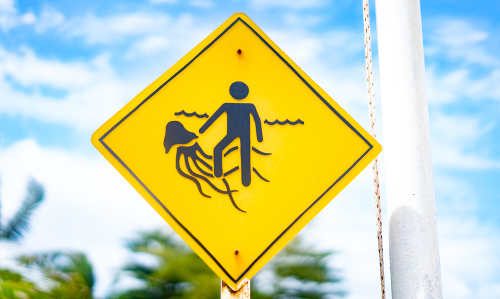Ever wondered how to enjoy Australia’s beaches safely during jellyfish season? Whether you’re a tourist exploring the coastline, a parent planning a family day out, or an expat who simply loves to swim, knowing what to expect can make your beach trips safer and more enjoyable.
Jellyfish can cause painful stings, and some carry a risk of more serious complications—but with the right information and precautions, you can still enjoy a great day at the beach. This guide from Remitly gives you clear, practical, easy-to-follow tips to stay safe during jellyfish season in Australia.
When is jellyfish season in Australia?
Jellyfish season in Australia usually runs from November to May, when the ocean waters are warmer and jellies move closer to the coastline. While you might spot jellyfish at other times of the year, the peak season almost always falls during this warmer stretch.
If you’re moving to Australia or planning a beach trip during this time, remember it overlaps with the summer and holiday seasons. Jellyfish season is especially important to note if you’re visiting tropical parts of Australia, like Queensland, the Northern Territory, and northern Western Australia.
Jellyfish are often present during this season in popular spots like the Great Barrier Reef, Cairns, and Darwin. To help inform and protect swimmers, local councils usually put up clear warning signs, so keep an eye out for these if you’re not sure whether it’s safe to swim.
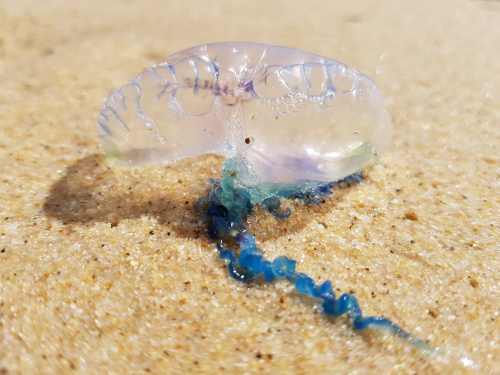
Common types of jellyfish
There are a few species of dangerous jellyfish commonly found in Australia:
Box jellyfish
Box jellyfish are translucent and have a cube-shaped body with long, thin tentacles. They’re most often spotted in Queensland and the Northern Territory. Their sting is very painful and can cause life-threatening heart complications, making box jellyfish first aid procedures critical. If stung, get medical help right away.
Irukandji jellyfish
Irukandji jellyfish are tiny—almost invisible in the water—and are usually found in northern and eastern Australian waters. Don’t be fooled by their size. Their sting can cause severe pain, vomiting, and a racing heartbeat. If stung by an Irukandji jellyfish, seek medical assistance immediately.
Bluebottle (Portuguese man-of-war)
Bluebottles are easy to spot with their blue or purple float resting on the water’s surface and long tentacles trailing below. They’re common along Australia’s eastern and southern coasts. While their sting is painful and can leave red welts, it’s usually less dangerous than box or Irukandji stings. A simple first-aid treatment can bring quick relief.
Lion’s mane jellyfish
Lion’s mane jellyfish are big and hard to miss, with long, trailing tentacles that can stretch several meters. They’re often found in the cooler southern waters off Victoria and Tasmania. While their sting can be painful and cause redness or mild swelling, it’s rarely dangerous.
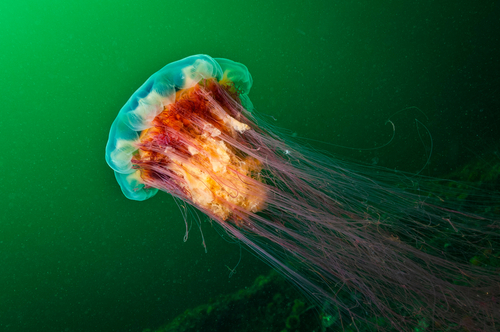
What are the high-risk areas during jellyfish season in Australia?
During jellyfish season, certain coastal areas in Australia pose a much higher risk for swimmers than others. These tend to be tropical areas, where the most dangerous jellyfish occur.
The northern Queensland coast
The stretch from Cairns to Port Douglas is a hotspot for box jellyfish and Irukandji. Because of the calm, slow currents, jellyfish can drift closer to shore.
Many popular swimming spots have stinger nets in place to protect swimmers. Even so, it’s smart to stay cautious, especially if you’ve got kids or inexperienced swimmers with you.
The Great Barrier Reef
The reef may be a major tourist attraction, but its sheltered lagoons create perfect conditions for jellyfish. If you’re snorkeling or diving, you might see them drifting near the surface. Local tour operators often brief visitors on seasonal risks and what to do in case of a sting.
Northern Territory beaches
Darwin and the nearby coastal areas are known for their warm, shallow waters, which attract jellyfish during the season. The beaches may be less crowded than those in Queensland, but jellyfish stings can be just as dangerous. So be sure to check local alerts and follow safety advice.
The northern coast of Western Australia
Tropical shores near Broome and the Kimberly often see more jellyfish during the summer months. The calm waters and sheltered bays let them drift closer to shore, so be sure to check local council updates for recent information.
Any warm, calm waters
Beyond the main tourist spots, jellyfish are often found in calm bays, estuaries, and lagoons where the water tends to be warmer. Even if you’re not in a hotspot, it’s still smart to check seasonal reports or ask local authorities for updates before getting in the water.
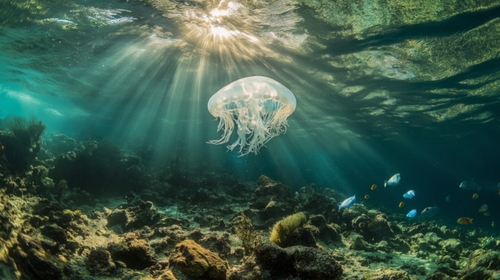
Safety tips for enjoying the water
Besides avoiding the most dangerous areas during jellyfish season, there are some additional safety tips you can follow to protect yourself and your family.
Wear protective clothing
Stinger suits are one of the best ways to protect your skin from jellyfish tentacles. They’re lightweight and flexible, so you can move freely while being protected from stings.
Be sure to wear protective clothing in northern waters, where box jellyfish are common. Even a thin layer can make a big difference, helping you avoid painful encounters and enjoy your swim with confidence.
Use designated swimming areas
Swimming in areas monitored by lifeguards and protected with stinger nets gives you an extra layer of safety. Lifeguards and beach patrols check these zones regularly for jellyfish and other hazards, which lowers the chance of unexpected encounters.
By sticking to the designated boundaries, you minimize your risk, enjoy the ocean with peace of mind, and have the assurance that help is available right away if you need it.
Pay attention to warning signs
Beach warning signs aren’t just suggestions; they share real-time updates about jellyfish sightings or stinger activity. Sometimes, they signal a temporary closure, and other times, they may urge extra caution in certain spots.
Paying attention to these warnings is a smart decision. Even if the water looks clear, jellyfish can drift silently just below the surface. Some jellyfish are so small they can hardly be seen—the best Irukandji safety tip is to follow any caution signs posted at the beach.
Avoid reported jellyfish zones
If lifeguards or local authorities report jellyfish in an area, be sure to avoid swimming there even if the water looks safe. Jellyfish are often hard to spot until you’re right next to them, so entering these zones increases your risk of getting stung.
While swimmers in most countries may only encounter mild stings, Australia is home to some of the world’s dangerous jellyfish, making it crucial to take warnings seriously. Planning your swimming in safe areas is an easy way to prevent painful or even serious incidents.
Carry vinegar or sting relief products
Keeping vinegar or jellyfish sting relief nearby is a simple but essential precaution. Vinegar can neutralize venom from dangerous species like the box jellyfish, and using it right after a sting helps ease pain. Tuck a small bottle in your beach bag so it’s always ready when you need it.
Swim with a buddy
Don’t swim alone in waters where jellyfish might be present. A buddy can help if you get stung, call for help, or provide first aid right away. It’s essential at less supervised or remote beaches, where assistance may not be close by. Swimming with someone also gives you a sense of security and confidence in the water.
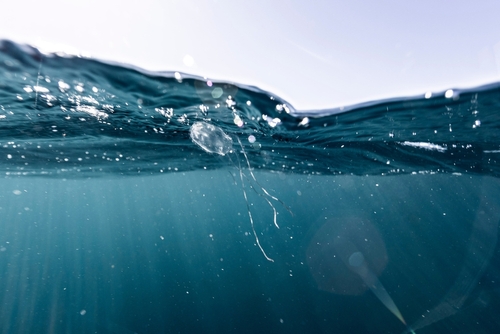
First aid for jellyfish stings
Acting quickly after a jellyfish sting can greatly reduce pain and prevent serious complications. Here’s a simple step-by-step guide for handling the most common stings in Australia:
Box jellyfish stings
Box jellyfish stings require immediate attention. If you get stung, pour vinegar directly on the area to neutralize the venom, and avoid rubbing the sting, which can make it worse.
Seek help right away and apply pressure immobilization if local authorities or medical professionals recommend it. Acting quickly can save your life.
Bluebottle stings
Bluebottle stings can be painful but are usually less dangerous. Rinse the area with salt water and apply hot water (around 45°C) or a heat pack for 20-45 minutes to ease the pain.
Ice packs can also reduce swelling and discomfort. Avoid using vinegar on bluebottle stings, as it may make the irritation worse.
General precautions
Always bring a small first-aid kit when visiting beaches during jellyfish season, including vinegar, heat packs, gloves, and tweezers for safely removing tentacles. Make sure you know where the nearest medical facilities or beach patrols are in high-risk areas. Being prepared helps you respond quickly and stay safe if a sting happens.
Why awareness matters
Understanding jellyfish isn’t only about keeping yourself safe—it also helps protect the environment and the wider community.
By knowing where jellyfish are, you can avoid stings while minimizing harm to these important creatures that play a key role in marine ecosystems. Giving them space helps preserve biodiversity and keep the ocean healthy for everyone.
By paying attention to warnings, swimming in designated areas, and reporting jellyfish sightings, you’re keeping the community safe and ensuring everyone can enjoy the water responsibly.
Stay safe and enjoy Australia’s beaches
Jellyfish season in Australia generally runs from late spring to early autumn, with northern and tropical waters seeing the most activity. By knowing when and where jellyfish are most likely to appear, wearing protective clothing, and keeping basic first-aid supplies on hand, you can make your beach trips safer and more enjoyable.
With the right knowledge and precautions, visiting the beautiful beaches of Australia can be an exhilarating experience. Share this guide with friends and family heading to the coast, and check out additional resources such as local marine authority updates or first-aid workshops to make the most of your beach experience.
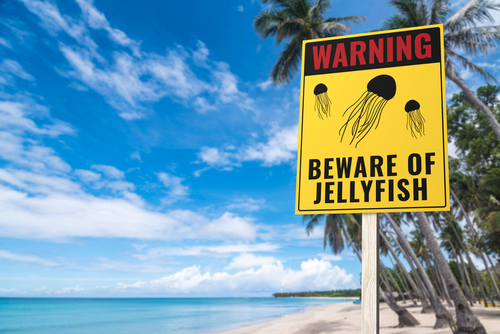
FAQs
What are the most dangerous jellyfish in Australia?
The box jellyfish and Irukandji jellyfish are considered the most dangerous due to their potent venom, which can cause serious health issues.
How can I protect myself during jellyfish season?
Wear stinger suits, swim only in designated protected areas, and follow any warning signs or advice from lifeguards. Keep in mind that some jellyfish can sting through thin clothing or swimwear.
What should I do if stung by a jellyfish?
If you are in tropical waters, where the most dangerous jellyfish are found, remove any tentacles and pour vinegar on the sting, then seek medical attention. If you are not in a tropical zone, wash the sting with seawater.
Are Australian beaches safe during jellyfish season?
Yes, as long as you follow safety precautions and stay informed, beaches in Australia remain a safe and enjoyable place to visit.
